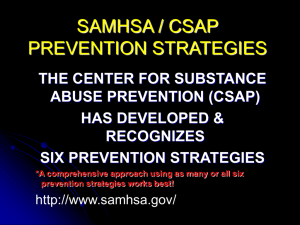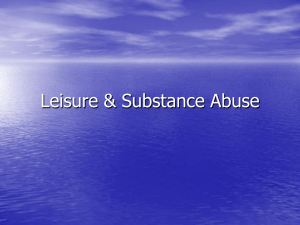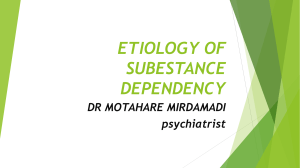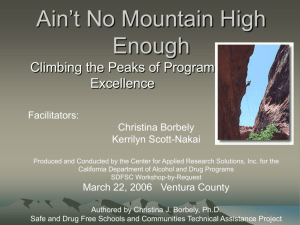Prevention
advertisement
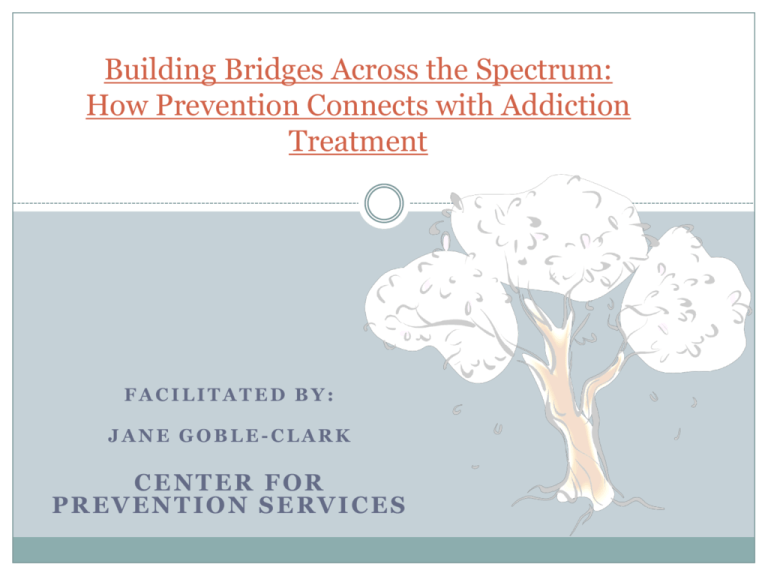
Building Bridges Across the Spectrum: How Prevention Connects with Addiction Treatment FACILITATED BY: JANE GOBLE-CLARK CENTER FOR PREVENTION SERVICES Agenda Hour 1 - Welcome and Introductions - What is Prevention? - Prevention Strategies BREAK Hour 2 - Prevention 101 continued - Shared Skills: Collaboration - Experiential learning BREAK Hour 3 - Shared Skills: Cultural Competency - Experiential learning Introductions WELCOME ! 1. Facilitator and Agency background 2. Audience -- Why is this topic important and relevant to the work you do? What will we accomplish today? Discussion of how prevention spans and is relevant to addiction treatment Discussion of the differences between collaboration and compromise and how to use that to find unity in the diversity of professions Discussion of cultural competency as a professional tool and as a bridge between the fields of prevention and treatment Create new networking opportunities and provide links Q&A Norms for Today’s Training Start and end on TIME Ask for clarification Each person is a resource to the whole group Be respectful of each other’s opinions and expertise HAVE FUN!!! What else? Group Activity Circle of Friends - Please form two circles with your classmates - Create a smaller circle of people to be the inner loop - Create a larger circle of people to be the outer loop - People in inner and outer circles face each other (like a dance!) - The facilitator will give quick Q & A, then - Each group moves to their left after specified time - Finishes when everyone has met each other! Common Prevention Quotes “An apple a day keeps the doctor away.” “An ounce of prevention is worth a pound of cure.” “Prevention is better than cure.” “A stitch in time saves nine.” CSAP’s Definition of Prevention “Prevention is a proactive process. It empowers, individuals, and systems to meet the challenges of life events and transitions by creating and reinforcing conditions that promote healthy behaviors and lifestyles.” - William Lofquist, CSAP - Center for Substace Abuse Prevention NCSAPPB’s Definition of Prevention “Substance Abuse Prevention is the reduction, delay, or avoidance of alcohol and other drug use. Prevention promotes positive environments and individual strengths that contribute to personal health and well-being over an entire life span. Effective prevention strategies encourage individuals, families, and communities to take part in assessing and changing their lifestyle and environments.” NCSAPPB - North Carolina Substance Abuse Professional Practice Board Who Does Prevention? Grandparents Parents Preventionists Youth Teachers Counselors Treatment Providers Aunts/Uncles You Me Community Members EVERYONE!! Why Provide Prevention Services? “Drug use is not a national problem…it is a series of local epidemics.” ~ “Prevention is not about one program or activity…it is about making it part of the ground water—the way communities do business.” The Continuum of Care Different levels of prevention are distinguished by the level of risk of disorder/distress in various populations groups targeted. Types of Prevention on the Continuum Individual / Familial Indicated Selective Environmental Universal IOM Prevention Components Universal Prevention: Addresses the entire population Aim is to prevent/delay use of ATOD. Deters onset by providing individuals with information/skills Selected Prevention: Targets subsets of the population considered at risk by virtue of their membership in a particular segment of the population Key Selected Prevention targets the entire subgroup regardless of the degree of risk of any individuals in the group Indicated Prevention: Targets individuals who are exhibiting early signs or consequences of ATOD use. IOM - Institute of Medicine Prevention Domains ► Individual/Peer ► Family ► School ► Community Substance abuse and mental illness are complex problems that develops in response to multiple influences. Each domain presents an opportunity for preventive action. Individual/Peer/Family = Individual-level strategies School/Community/Society = Environmental strategies Prevention Domains Individual Experiential Learning: Family Peer School Community Society Circle of Support -Begin with one person in the middle -Add additional members to the activity -How does this exercise answer the question below? Why target each of these areas? The Community Wheel CSAP’s Prevention Strategies Information Dissemination Prevention Education Alternatives Problem Identification & Referral Community Based Processes Environmental Approaches What are some examples of these strategies? Strategies: Information Dissemination Media Campaigns Brochures Videos Radio and Television Public Service Announcements Lectures Health Fairs Resource Directories Clearinghouses and other information centers One Time Talks Got Questions? Call Drug Line 704-375-DRUG (3784) All calls are anonymous and confidential Strategies: Prevention Education Classroom and Small Group Sessions Parenting and Family Management Classes Peer Lead and Peer Helper Programs Education Programs for Youth Groups Groups for Children of Substance Abusers Strategies: Alternatives Mentoring Programs Drug Free Social and Recreational Activities - Ex. SAAM Family Festival Community Service Activities Drug Free Dances and Parties Youth and Adult Leadership Activities Community Drop-in Centers Strategies: Problem Identification and Referral Driving-while- intoxicated Education Programs Employee Assistance Programs Student Assistance Programs Strategies: Community Based Approaches Building Interagency Collaboration Training Community Members/Agencies in Substance Use Education and Prevention Conducting Systematic Planning Supporting Community Team-Building Piedmont Area Substance Abuse Provider Association Substance Abuse Training Series Hosted by: PASAPA and PBH 8:30 AM - 12:00 PM Environmental Approaches Community laws that prohibit alcohol and tobacco advertisements in close proximity to schools The establishment and review of school drug policies Technical assistance to communities to help them maximize law enforcement efforts to govern the availability and distribution of drugs Community policies regarding access to alcohol and tobacco products Community laws that increase punishments for DUIs BREAK Experiential Learning Planning A Community Center Rules: - Each person gets to make one line on the board - No conversation allowed - Complete the plan - The group processes the shared work Public Health Model Individual Prevention: Focuses on trying to change the host Environmental Prevention: Focuses on trying to change the agent and the environment Why Plant the Seed of Prevention? Those who consume alcohol before the age of 15 are 5 times more likely to have an alcohol problem later in life. Youth drug use is associated with suicide, violence, unwanted pregnancies, school failure, delinquency, and transmission of sexually transmitted infections The Role of Prevention To create communities in which people have a quality life: Healthy environments at work & in school Supportive communities and neighborhoods Connected to families and friends Alcohol, tobacco, and other drug-free lifestyles Addiction and crime-free individuals and communities The Roots of Prevention 1950s Scare Tactics 1960s Scare Tactics and Information 1970s Drug Education and Alternatives to Drug Use 1970s-1980s Education, Alternatives, and Trainings 1980s-1990s Parent, School, and Community Partnerships 1990s Use of Evidence-based “Model Programs” 2000s Strategic Prevention Framework and focus on cultural competency and sustainability New Growth Strategic Prevention Framework Assessment, Capacity, Planning, Implementation, Evaluation, Sustainability, and Cultural Competence Risk and Protective Factors Community, School, Family, and Peer/Individual SAMHSA’s Strategic Prevention Framework Steps Assessment Profile population needs, resources, and readiness to address needs and gaps Evaluation Monitor, evaluate, sustain, and improve or replace those that fail Sustainability & Cultural Competence Implement evidencebased prevention programs and activities Implementation Capacity Mobilize and/or build capacity to address needs Develop a Comprehensive Strategic Plan Planning SPF: A shared framework Benefits of the Strategic Prevention Framework: Creates an objective community profile Identifies how to effectively and efficiently use resources Assists in the selection and implementation of effective strategies Unifies the power of individual citizens and institutions Create a comprehensive plan in which everyone in the community has a stake Holds community institutions accountable Risk & Protection Approach In past century, doctors have discovered factors that: Put people at risk for such things as heart disease and diabetes. Protect people from such conditions This Risk and Protective Factor approach follows the same model for prevention for our communities’ children Risk Factors are listed to the left. What are some Protective Factors? Risk & Protection Approach A Simple Premise What are Risk Factors? Conditions or situations that increase the likelihood that a child will develop one or more health and/or behavior problems in adolescence. What are Protective Factors? Conditions or situations which decrease the likelihood of future behavior problems. Where are they found? In four domains Community, School, Family, Peer/individual Prevention: Where We Are Now Prevention planning is strategic Based on risk and protective factors Prevention movements, rather than individual programs Strategies are evidence-based Addresses the whole community culture “Prevention is Health Reform” Science-Based Prevention Programs Identified and or substantiated through an expert consensus or analytical process using commonly agreed on criteria National Registry of Effective Practices and Programs (NREPP) www.nrepp.samhsa.gov Why is science-based important? Past and Present Prevention Prevention Services Prevention Agencies or Programs Centers for Prevention Resources Prevention Policy Alliance TRU Specialty Contracts Youth Suicide Prevention Methamphetamine Prevention Initiative Prevention Services Safe and Drug Free Schools and Communities Fetal Alcohol Spectrum Disorders Prevention Underage Drinking Prevention Early Interventions Bullying Prevention Violence Prevention Suicide Prevention Juvenile Crime Prevention Community Prevention 24/7 Social Host Youth Leadership Community Policing Alcohol Compliance Checks Tobacco Reward/Reminder Visits Responsible Beverage Sales and Service Prevention Outcomes Youth Drug Survey Tracks trends in use and abuse Covers 40 years 2010 data is most recent Synar Decrease in sales of tobacco to minors from 48.3% to 8.2% Things to Remember about Prevention It is a process, it doesn’t happen overnight Environmental prevention is more effective than an Individual approach It spans SA, MH and DD What Can You Do? Call your local prevention service providers Become active in your local coalitions Call your school board members, city officials and state officials asking them to support prevention initiatives Talk to your children, grandchildren, niece, and nephews Be active in your community and in children’s lives Raise awareness in your own profession Share resources with clients BREAK Crossing the Bridge Relationship-building Collaboration vs. Compromise Cultural Competency Strategies for Relationship-building Experiential Learning: The Head-band Activity Volunteers Needed! You won’t look as “stylish” as this guy. . . but you will have fun! Strategies for Relationship-building The Head-band Activity: DISCUSSION What observations do you have about the actions and behaviors in the role play? How does this scenario exemplify the process of creating collaborations? Other questions? Strategies for Relationship-Building Active listening Ask questions Be open to suggestions Willingness to learn new perspectives without judgment Respect Focused body language or tone of voice Authentic desire for collaboration Ugli Orange Case (10 minutes) Pair up Negotiate and make the best deal you can Choose carefully how much information you will reveal Collaborative vs. Compromise “Let’s meet both our needs and interests.” “Let’s split the difference.” Problem solving attitude 50/50 solutions Sharing information Nobody fully gets what they want Mutual satisfaction & investment of time Blaming and resentment Principled Negotiation People: Separate the people from the problem Interests: Focus on interests not positions Options: Generate a variety of possibilities before deciding what to do Criteria: Result based on a fair standard, independent of either side Seize the Day: Recognizing and Maximizing an Opportunity to Collaborate Relationship between individuals Willingness to acknowledge historical/ cultural/organizational back-stories Willingness to create a new story Trust that everyone’s best interest will be represented Q&A Resources Substance Abuse and Mental Health Services Administration – www.samhsa.gov/prevention National Institute on Drug Abuse – www.drugabuse.gov Foundation for a Drug Free World - www.drugfreeworld.org National Multicultural Institute – http://www.nmci.org/ Teaching Tolerance- http://www.tolerance.org/ Contact Information Jane Goble-Clark, Executive Director goble-clark@preventionservices.org Office: 704.375.3784 Web: www.preventionservices.org



